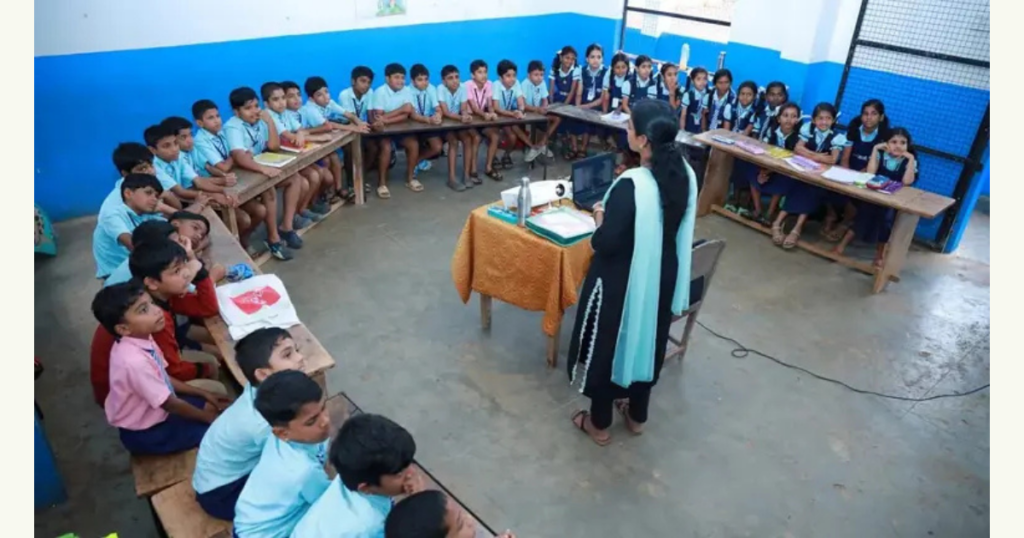A 2024 Malayalam film inspires Kerala schools to adopt circular seating, promoting equality and inclusion in classrooms across the state.
In an inspiring example of art influencing life, a Malayalam children’s film titled Sthanarthi Sreekuttan is reshaping how students sit and learn in classrooms across Kerala—and even beyond. Released in 2024, the film’s message has gone far beyond the screen, sparking a real-world movement toward more inclusive and egalitarian classroom environments.
At the heart of this quiet revolution is a simple but powerful idea: remove the hierarchy in the classroom. The film’s final scene portrays students sitting in a circle—a symbolic arrangement that does away with the traditional notions of frontbenchers and backbenchers. Everyone faces each other. Everyone is equal.
This idea deeply resonated with both teachers and educationists, especially in schools with smaller class sizes. So far, at least seven schools in Kerala have implemented this seating style, with one school in Punjab following suit. Classrooms that once followed rigid rows now have a more open, interactive feel, encouraging communication, collaboration, and equal participation.
Schools that have adopted circular or U-shaped seating include RCC LPS East Mangad in Thrissur, GHSS Tholanur in Palakkad, RVV HSS Valakom in Kollam, and Pappinisseri West LP School in Kannur, among others. These schools, often with fewer students per class, found the transition both feasible and beneficial.

For the film’s director, Vinesh Viswanath, the unexpected real-world impact of his story has been nothing short of heartwarming. Speaking to India Today, he expressed his joy and disbelief:
“Cinema definitely can bring about a positive impact in society. Malayalam films like Ustad Hotel and Traffic have shown that. As a filmmaker, nothing is more satisfying than seeing your ideas come to life and make a difference.”
Viswanath also revealed that the concept for Sthanarthi Sreekuttan was partly inspired by the 2014 Tamil film Kaaka Muttai, a critically acclaimed children’s movie known for its emotional depth and strong social message. He and his team wanted to create a similarly meaningful story, crafted especially for children, but with themes that would touch everyone.
Among those moved by the film was Albert Christin, a teacher at RCC LPS East Mangad. For him, the movie was a nostalgic trip down memory lane.
“So many scenes reminded me of my own school days,” he said. “The circular seating in the climax really stood out to me. I teach just 20 students, so it wasn’t difficult to put the idea into practice.”
He also acknowledged that while such a seating model works well in smaller classrooms, it may not be practical in larger ones with 50–60 students. However, he pointed out that the Kerala education department has always supported flexibility in seating arrangements, giving teachers the freedom to make thoughtful changes in their classrooms.
What’s most striking is the broader message this movement conveys. In an age where concerns about the influence of cinema on children and youth often make headlines, Sthanarthi Sreekuttan shows how powerful and positive that influence can be. Rather than glamorize violence or promote stereotypes, the film advocates empathy, equality, and inclusion—values that are crucial in today’s education system.
As for what’s next, Vinesh Viswanath says his upcoming project will explore a completely different genre. But the social relevance of Sthanarthi Sreekuttan has left a lasting impression on him:
“This was my debut film, and to see it spark real change—it’s incredibly rewarding. It shows that even a small story told with sincerity can start something big.”
Indeed, Sthanarthi Sreekuttan is more than a film—it’s a quiet revolution in how we look at classrooms, learning, and the importance of seeing every child as equal.
IIT Madras Launches Online Course for Sircilla School Students –